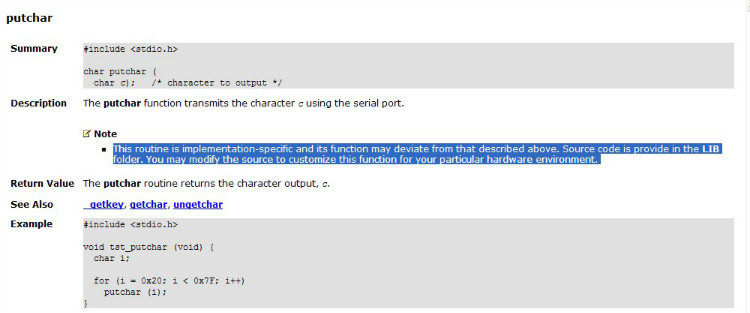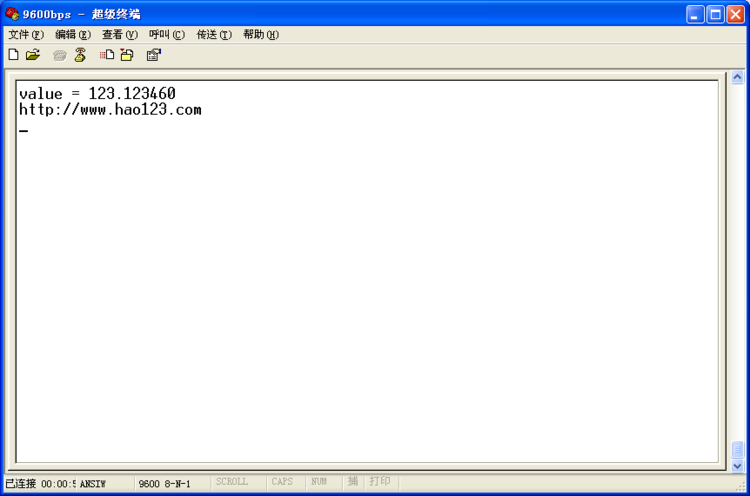MSP430G2553單片機(jī)使用printf函數(shù)進(jìn)行串口打印輸出
帶著疑惑我查看了keil的幫助文件里面的printf函數(shù)說明,原來printf函數(shù)最終是調(diào)用putchar函數(shù)來實(shí)現(xiàn)打印輸出字符的。

putchar,該函數(shù)將制定的表達(dá)式的值所對應(yīng)的字符輸出到標(biāo)準(zhǔn)輸出終端上。表達(dá)式可以是字符型或整型,它每次只能輸出一個字符。我們來看keil標(biāo)準(zhǔn)函數(shù)庫里的putchar函數(shù)的函數(shù)體。

#include
#define XON 0x11
#define XOFF 0x13
/*
* putchar (full version): expands n into CR LF and handles
* XON/XOFF (Ctrl+S/Ctrl+Q) protocol
*/
char putchar (char c) {
if (c == n) {
if (RI) {
if (SBUF == XOFF) {
do {
RI = 0;
while (!RI);
}
while (SBUF != XON);
RI = 0;
}
}
while (!TI);
TI = 0;
SBUF = 0x0d; /* output CR */
}
if (RI) {
if (SBUF == XOFF) {
do {
RI = 0;
while (!RI);
}
while (SBUF != XON);
RI = 0;
}
}
while (!TI);
TI = 0;
return (SBUF = c);
}
#if 0 // comment out versions below
/*
* putchar (basic version): expands n into CR LF
*/
char putchar (char c) {
if (c == n) {
while (!TI);
TI = 0;
SBUF = 0x0d; /* output CR */
}
while (!TI);
TI = 0;
return (SBUF = c);
}
/*
* putchar (mini version): outputs charcter only
*/
char putchar (char c) {
while (!TI);
TI = 0;
return (SBUF = c);
}
#endif
由說明文件可以看出,我們可以改寫這個底層的putchar函數(shù)來適應(yīng)不同的硬件。keil里面的putchar函數(shù)是默認(rèn)用串行口輸出信息的,我們可以自由定義成另外的輸出模塊,比如自定義IO向1602液晶輸出信息。
keil的printf函數(shù)大致搞明白了,回頭再研究下IAR for MSP430,可惜,我沒有能夠查看該軟件標(biāo)準(zhǔn)函數(shù)庫里的printf.c 和 putchar.c,不過我覺得程序沒有通過串口向電腦打印輸出信息,是因?yàn)榈讓拥膒utchar函數(shù)沒有定義為通過MSP430G2553的UART進(jìn)行輸出,那如果我自己重定向一個putchar函數(shù),覆蓋掉標(biāo)準(zhǔn)函數(shù)庫里面的putchar,是不是就能夠輸出了呢。于是編寫putchar函數(shù)如下:
/*********************************************************************
* 函數(shù)名 : putchar,函數(shù)重定向,自動覆蓋標(biāo)準(zhǔn)庫函數(shù)
* 函數(shù)功能 : 向串口終端發(fā)送一個字符
* 形參 : c為待發(fā)送的字符
* 返回值 : c
*********************************************************************/
int putchar(int c)
{
if(c == n)
{
while(UCA0STAT & UCBUSY);
UCA0TXBUF = r;
}
while(UCA0STAT & UCBUSY);
UCA0TXBUF = c;
return c;
}
編譯后,輸出完全正確。大功告成。
將測試程序向大家展示一下,希望能幫到大家。
////////////////////////////////////////////////////////////////////////////////////////////////////////////////////////////////////////////////
uart.c
////////////////////////////////////////////////////////////////////////////////////////////////////////////////////////////////////////////////
#include <msp430g2553.h>
/**********************************************************************
* 函數(shù)名 : UartInit
* 函數(shù)功能 : 初始化msp430g2553的USCI寄存器,使其工作在UART模式
* 形參 : 無
* 返回值 : 無
* ********************************************************************/
void UartInit()
{
BCSCTL1 = CALBC1_1MHZ; // Set DCO
DCOCTL = CALDCO_1MHZ;
BCSCTL2 &= ~(DIVS_3);
P1SEL = BIT1 + BIT2 ; // P1.1 = RXD, P1.2=TXD
P1SEL2 = BIT1 + BIT2; // P1.1 = RXD, P1.2=TXD
UCA0CTL1 |= UCSSEL_2; // SMCLK
UCA0BR0 = 104; // 1MHz 9600
UCA0BR1 = 0; // 1MHz 9600
UCA0MCTL = UCBRS0; // Modulation UCBRSx = 1
UCA0CTL1 &= ~UCSWRST; // **Initialize USCI state machine**
UC0IE |= UCA0RXIE; // Enable RX int
}
/*********************************************************************
* 函數(shù)名 : putchar,函數(shù)重定向,自動覆蓋標(biāo)準(zhǔn)庫函數(shù)
* 函數(shù)功能 : 向串口終端發(fā)送一個字符
* 形參 : c為待發(fā)送的字符
* 返回值 : c
*********************************************************************/
int putchar(int c)
{
if(c == n)
{
while(UCA0STAT & UCBUSY);
UCA0TXBUF = r;
}
while(UCA0STAT & UCBUSY);
UCA0TXBUF = c;
return c;
}
////////////////////////////////////////////////////////////////////////////////////////////////////////////////////////////////////////////////
main.c
////////////////////////////////////////////////////////////////////////////////////////////////////////////////////////////////////////////////
#include
#include "uart.h"
#include "stdio.h"
void main()
{
float value = 123.123456789;
char *string="http://www.hao123.com";
WDTCTL = WDTPW + WDTHOLD;
UartInit();
printf("value = %fn%sn",value,string);
while(1);
}
信息打印輸出到電腦的超級終端,截圖如下:




評論